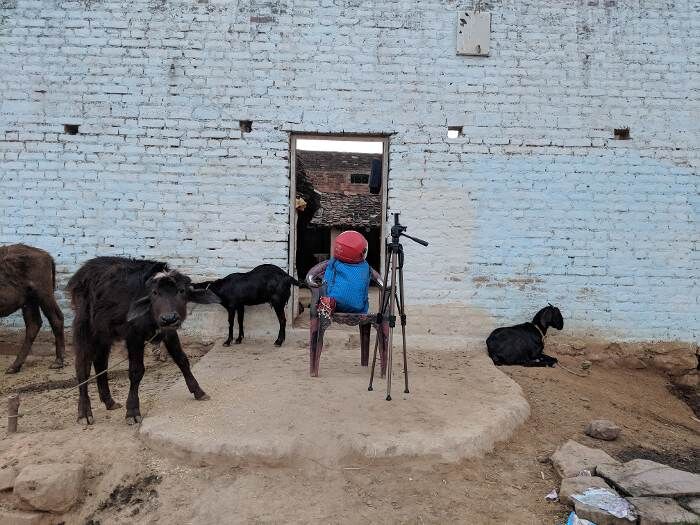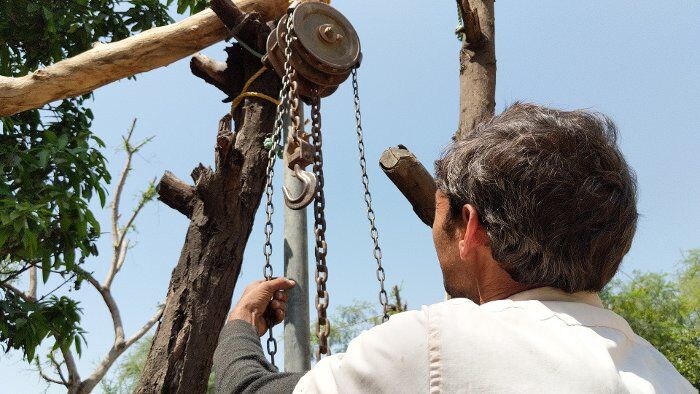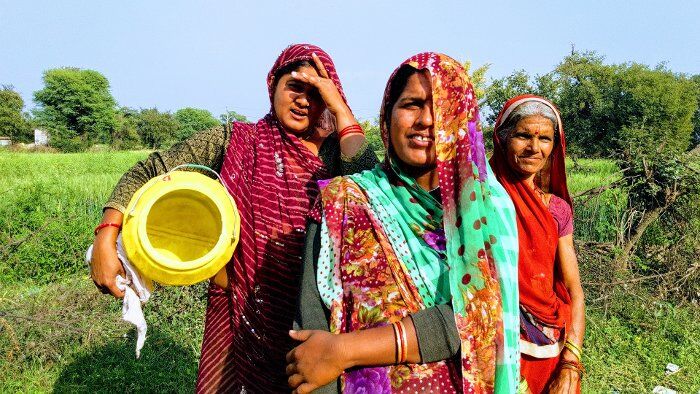Two reporters, one bike and a 500-km ride across Bundelkhand. For Gaon Connection reporters Jigyasa Mishra and Pragya Bharti, these seven days were a mix of fun, adventure, learning and some serious journalism. They visited many villages and tried to understand life from women’s perspective. This journey was about understanding their lives, struggles, hopes and aspirations.
Edited by: Swati Subhedar
Have you ever had to drink tea in lieu of water to quench your thirst?
We reached Rajola village in Madhya Pradesh at around 4 in the afternoon. It was a painfully humid day. We were too exhausted and desperately needed a break. So, we stopped at a small chai ka galla (tea stall). We wanted to buy a bottle of water. The spare one which we had, had very little water. The shopkeeper broke our heart.
He said we would not find water anywhere for miles. He offered to make us tea instead. Beggars are not choosers. It was imperative to save every drop of water we had, so we sipped on kulhar wali chai to quench our thirst.
That was a first for me.
While this may have been a one-off experience for me, for those living in Bundelkhand villages, this is a bitter truth they have to deal with on a daily basis.
The road leading to Rajola village – located in Pipariya tehsil of Hoshangabad district, 20 kms from the Uttar Pradesh-Madhya Pradesh border – was a back-breaking one. As soon as we entered the village, we saw scores of women carrying empty buckets in their hands. They were rushing to a hand pump – the only source of water in that village – to fill up their buckets – something that they had to do twice or thrice in a day.

We crossed a house. A few goats and buffaloes were tied in the yard. A young girl – her name was Suman — was giving water to her cattle. Once it was done, she picked a few plastic cans and started walking towards the handpump.
We caught hold of her.
“The handpump is just half a km away. I have to make 3-4 rounds every day. Would you like to come along?” she asked us.
We started walking along with her. We crossed a few narrow lanes, scourge of mosquitoes followed us. “Since there are lots of tress around, so there are lots of mosquitoes,” Suman said.
We reached the hand pump. A girl as old as Suman was, Nisha, was fiddling with the handpump, but it had probably gone dry. Suman kept her bucket in the queue.
Poor girl was struggling so badly, I couldn’t stop myself from asking Suman.
“Is there any water in this pump?
“This won’t start functioning till someone pumps it for half an hour or an hour. It then again goes dry, and we have to start the process all over again,” Suman said.
According to a Central Ground Water Board (CGWB), Ministry of Water Resources report:”Underground water level has been depleting fast in the past 10 years in Madhya Pradesh. But the water is getting replenished at a slower rate and that too only in some areas.
“On an average we spend half a day fetching water,” said Suman.
Few days before the trip had started, I had visited Lodhvara village in Chitrakoot. “The situation is still better now than in June. The hand pumps run dry by June. Though we call for water tankers, they do not turn up regularly. When we run short of storages for water, we have to ask our neighbours. We don’t like summers. It frightens us,” Rampal, a local resident, had told me then.
According to the 2018 report of United Nations Educational, Scientific, and Cultural Organization (UNESCO), India is the world’s largest consumer of underground water, followed by China, and then America.
Water crises is a major problem for all in Bundelkhand. From youngsters to elderly, everyone gets affected by water scarcity. It’s a major cause of worry.Hand Pumps do not function properly. Bore wells run dry in summers.

The main reason behind depleting underground water level is that we are shamelessly mining water. According to a report published in India Spend in July 2016, there are around 30 million structures for drawing ground water.
When we reached Mahkona, we saw a few people deliberating over something. When we went closer, we saw a man was repairing a water motor. They didn’t open up initially, but once they did, they told us in details how bad the situation was.
“This motor was provided to us by the government, but it has stopped working. The government is not bothered, so we have pooled in some money and we are getting it repaired. Water is a basic commodity. We can’t do anything without it,” said Santosh, the mechanic.
When I asked him if they had informed the village head, they got a big angry. “We would go to his place every single day. He turned us back every single time saying he does not have the budget. We didn’t have any option. This is the only borewell in the village. We have to make it functional.”
For people living here, it’s a double whammy. They have to suffer severe drought and water scarcity during summers between March and July. And post that, they have to deal with floods.
“The Satna river is just 200 meters from here. The barren land that you see here, it gets flooded during monsoon. It ruins everything. We go out of business for two-three months. We are forced to keep our kids at home as schools get submerged and the furniture gets damaged,”said Bablu while pointing towards the dried river land.
Interestingly, just like Ken, Dhasan, Sunar and Vyarma rivers flowing through Bundelkhand, the Satna river too is on the verge of extinction.
It was post noon and we could have gulped a litre of water in one go. When we asked Bablu if there was a shop close by where we could buy water, Bablu took us to his place. He offered us biscuits, snacks and water. We were touched by his hospitality. It didn’t feel strange that we were at a stranger’s house in the middle of nowhere.
I emptied my bag to find the only water bottle I had. The pepper spray stumbled out. How wrong we were while packing it before leaving. Throughout the course of our journey, we met strangers who went out of their way to help us. Pepper spray was not even needed, we should have, instead, kept dozens of water bottles.

It was so dry and humid that we felt like drinking water every 10 minutes. We bought water when we could but, mostly, we had to rely on strangers. It made us realise, how recklessly city folks waste water and use it unabashedly while taking shower, in bathtubs or in flush when people in regions like Bundelkhand have to walk for miles just to fill a pitcher. Women in scores of villages like Mehkona have to sacrifice hours of their days fetching water.
We often see images of women in villages standing in long queues with colourful buckets to fetch water. These pictures come out really well, but often we fail to understand the pain that these women have to go through. Most of us, who have easy access to water, would never understand their pain.
When we left Mehkona, I realized how fortunate I was that I get clean drinking water, whenever I want. Very basic, but so important.




















